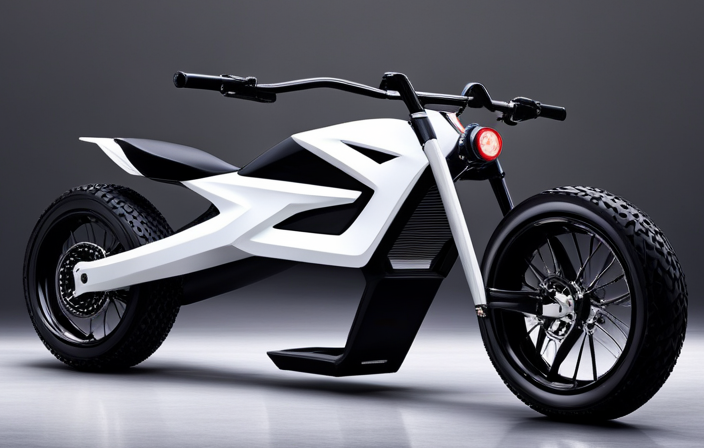Are you aware that the price of an electric bike battery can fluctuate significantly based on various factors?
As an electric bike battery specialist, I have delved deep into the world of electric bike batteries to provide you with accurate and detailed information.
In this article, we will explore the different types of electric bike batteries, the factors that influence their cost, and the average price range you can expect.
So, if you’re curious about how much an electric bike battery may set you back, keep reading to find out.
Key Takeaways
- Electric bike batteries can range in price from $200 to $800, depending on factors such as battery type, capacity, and brand.
- Lead-acid batteries are the least expensive option, while Li-ion batteries are the most expensive but offer lightweight and high energy density.
- Factors that influence battery cost include battery lifespan, efficiency of charging time, and brand reputation.
- Additional costs to consider include battery chargers and factors that can affect battery lifespan, such as temperature and charging habits.
Types of Electric Bike Batteries
Looking for the lowdown on electric bike batteries? Let’s talk about the different types available!
As an electric bike battery specialist, I have a deep understanding of the technical aspects of battery technologies. There are generally three main types of electric bike batteries: lead-acid, nickel-metal hydride (NiMH), and lithium-ion (Li-ion). Each type has its own pros and cons.
Lead-acid batteries are the least expensive option, but they are heavy and have a shorter lifespan. NiMH batteries offer a better energy density and longer lifespan, but they are also heavier and more expensive than lead-acid batteries. Li-ion batteries are the most expensive, but they are lightweight, have a high energy density, and a longer lifespan.
Factors such as battery capacity, voltage, and brand can influence battery cost. Now, let’s delve into the factors that influence battery cost.
Factors That Influence Battery Cost
Considering various factors, such as battery capacity, brand reputation, and technology advancements, there are several aspects that influence the price of an electric bike battery.
When it comes to battery lifespan, a higher quality battery with better materials and construction will generally have a longer lifespan, but it may also come at a higher cost.
Additionally, the efficiency of charging time plays a significant role in determining the battery price. Batteries that can be charged quickly and efficiently may be more expensive due to the advanced charging technology involved.
It is important to note that these factors can vary depending on the specific brand and model of the electric bike battery.
Moving forward, let’s explore the average price range for electric bike batteries.
Average Price Range for Electric Bike Batteries
To get an idea of the average price range for electric bike batteries, you can expect to pay anywhere from $200 to $800, depending on the factors mentioned earlier.
The cost of an electric bike battery can vary based on several factors, including battery type, capacity, and brand. Different types of electric bike batteries, such as lithium-ion and lead-acid, have varying price ranges due to differences in performance and lifespan.
Higher capacity batteries generally cost more as they can provide a longer range. Additionally, well-known brands often come with a higher price tag due to their reputation and quality.
It’s important to consider these factors when deciding on a battery for your electric bike. Moving forward, it’s also crucial to consider additional costs such as chargers and accessories that may be necessary for proper battery maintenance.
Additional Costs to Consider
When it comes to purchasing an electric bike, it’s essential to keep in mind the additional expenses that may arise, such as chargers and accessories necessary for proper battery maintenance. Battery chargers are an important consideration, as they can affect both the charging time and the lifespan of the battery.
There are different options available, including standard chargers, fast chargers, and smart chargers. Standard chargers are the most basic option and typically take longer to charge the battery. Fast chargers, on the other hand, can significantly reduce the charging time but may have a negative impact on the battery’s overall lifespan. Smart chargers are the most advanced option, as they can monitor the battery’s condition and adjust the charging process accordingly, optimizing both charging time and battery lifespan.
When choosing a charger, it’s important to consider your specific needs and prioritize between speed and battery longevity.
Additionally, there are several factors that can affect the lifespan of an electric bike battery. These include temperature, usage patterns, and charging habits. Extreme temperatures, such as high heat or freezing cold, can negatively impact the battery’s performance and longevity. It’s important to store and charge the battery in a temperature-controlled environment to maximize its lifespan. Regular usage and consistent charging can also help prolong the battery’s lifespan. It’s recommended to avoid letting the battery completely discharge and to charge it after each ride.
Over time, lithium-ion batteries may experience a decrease in their overall capacity, which is normal. However, proper maintenance and charging habits can help slow down this capacity loss.
In conclusion, when purchasing an electric bike, it’s important to consider the additional costs associated with battery maintenance, such as chargers and accessories. Choosing the right charger and adopting proper maintenance and charging habits can help extend the battery’s lifespan and optimize its performance.
[Transition Sentence: Now, let’s discuss some tips for extending battery life.]Tips for Extending Battery Life
One key to getting the most out of your electric bike’s battery is to treat it like a valuable asset. Extending the battery life and maximizing its performance requires a combination of proper maintenance and smart usage.
First and foremost, it’s important to charge the battery correctly by using the charger provided by the manufacturer and avoiding overcharging. Additionally, keeping the battery at a moderate temperature range and avoiding extreme cold or hot conditions can help prolong its lifespan.
Another tip is to avoid deep discharges and instead charge the battery before it reaches a low level. Furthermore, reducing the weight on the bike and optimizing the pedal-assist level can also help conserve battery power.
By following these tips, you can extend the life of your electric bike battery and ensure maximum performance.
Transitioning into the next section, let’s now explore where to buy electric bike batteries.
Where to Buy Electric Bike Batteries
When it comes to buying electric bike batteries, there are a few key options to consider.
Local bike shops are a great place to start, as they often carry a variety of battery options and can provide personalized advice based on your specific needs.
Online retailers, such as Amazon or specialized e-bike websites, offer a wide range of choices and the convenience of shopping from home.
Lastly, checking out manufacturer websites can give you direct access to the latest battery models and specifications.
It’s important to consider factors like battery type, capacity, and compatibility with your specific electric bike model when making your decision.
Local Bike Shops
To get an idea of how much an electric bike battery would cost, you can check out the prices at your local bike shops. These shops often carry a variety of battery options, from different brands to various capacities and voltages. Here are two reasons why local bike shops are a great place to start your search:
-
Expert advice: Local bike shops usually have knowledgeable staff who can provide you with expert guidance on choosing the right battery for your electric bike. They can answer any technical questions you may have and recommend the best battery based on your specific needs.
-
Customer reviews: When you visit a local bike shop, you can also ask other customers about their experiences with different electric bike batteries. Hearing firsthand reviews can help you make a more informed decision and find a battery that meets your expectations.
Now, let’s explore the next option for purchasing electric bike batteries: online retailers.
Online Retailers
Purchasing an electric bike battery from online retailers is like exploring a vast digital marketplace filled with endless options and hidden gems. As an electric bike battery specialist, I understand the importance of finding the right battery for your bike.
When shopping online, it’s crucial to consider battery compatibility with your specific electric bike model. Look for batteries that are designed to fit seamlessly into your bike’s frame and connect properly to the electrical system.
Another factor to consider is battery charging time. Some batteries offer fast charging capabilities, allowing you to quickly get back on the road. It’s important to check the specifications and charging times provided by the manufacturer. By doing so, you can ensure that you’re investing in a battery that meets your needs.
Now, let’s transition into the subsequent section about ‘manufacturer websites’.
Manufacturer Websites
Explore manufacturer websites to discover a treasure trove of information on the latest electric bike battery models that perfectly match your ride. As an electric bike battery specialist, I can assure you that these websites provide detailed information about battery specifications, performance, and maintenance. You’ll find precise terminology and clear explanations of complex concepts related to electric bike batteries.
Manufacturers also keep up-to-date with industry trends, regulations, and standards, ensuring that the information you find is reliable and accurate. When browsing these websites, you’ll come across a variety of charging options, including fast charging and removable batteries. This allows you to choose the option that best suits your needs and preferences.
As we move on to discussing warranty and return policies, it’s worth noting that manufacturer websites often provide valuable insights into these aspects as well.
Warranty and Return Policies
As an electric bike battery specialist, I can provide you with a deep understanding of warranty coverage, return and exchange policies.
When it comes to warranty coverage, it’s important to understand the specific terms and conditions outlined by the manufacturer. This will determine what repairs or replacements are covered and for how long.
Return and exchange policies can vary between retailers, so it’s crucial to familiarize yourself with their specific guidelines in case you encounter any issues with your electric bike battery.
Understanding Warranty Coverage
Imagine yourself riding through the city on your electric bike, knowing that your battery is protected by a warranty that shields you from unexpected costs.
As an electric bike battery specialist, I understand the importance of warranty coverage when it comes to ensuring the longevity and performance of your battery. Let’s delve into the technical aspects: battery performance and lifespan.
Electric bike batteries vary in terms of their capacity, voltage, and chemistry, which directly impact their performance. Factors such as the type of battery, usage patterns, and environmental conditions can affect the lifespan of your battery.
It is crucial to understand the warranty coverage for your specific battery and what it includes. Some warranties may cover defects in materials or workmanship, while others may offer a guarantee on battery performance. By being aware of the warranty coverage, you can make informed decisions and maintain your battery properly.
Now, let’s explore the next topic of return and exchange policies.
Return and Exchange Policies
To ensure a hassle-free experience, make sure you familiarize yourself with the return and exchange policies for your electric bike battery. It’s important to know how long the warranty duration is and what it covers. Additionally, understanding the customer support options available to you can be invaluable in case you encounter any issues with your battery.
Some manufacturers offer a 30-day return policy, while others may have a longer period of 60 or 90 days. It’s also important to note whether the warranty covers defects or malfunctions, as well as accidental damage. Knowing these details can give you peace of mind and help you make an informed decision when purchasing an electric bike battery.
Now, let’s move on to the next section about battery recycling and disposal.
Battery Recycling and Disposal
Don’t overlook the importance of responsibly recycling and disposing of electric bike batteries. Improper disposal can have a detrimental impact on the environment, as these batteries contain toxic materials such as lead and lithium.
To ensure proper battery disposal, follow these steps:
-
Locate a designated battery recycling center in your area. Many recycling centers accept electric bike batteries and will dispose of them safely.
-
Remove the battery from your electric bike following the manufacturer’s instructions. This may involve disconnecting wires and removing screws.
-
Store the battery in a cool, dry place until you can take it to the recycling center. Avoid storing it near flammable materials.
-
When you’re ready, take the battery to the recycling center for proper disposal.
Considering the environmental impact of battery disposal, it’s essential to explore alternative battery options.
Alternative Battery Options
One potential solution to the environmental impact of battery disposal is exploring alternative options that are more sustainable. As an electric bike battery specialist, I am constantly researching and testing different alternative battery technologies to find the best options for electric bike users.
To grab your attention, let’s take a look at a comparison table of three alternative battery technologies:
| Battery Technology | Pros | Cons |
|---|---|---|
| Lithium-ion | High energy density, long lifespan | Expensive, potential safety risks |
| Nickel-metal Hydride | Environmentally friendly, affordable | Lower energy density, shorter lifespan |
| Lead-acid | Low cost, recyclable | Heavy, shorter lifespan, lower energy density |
Each of these alternative battery technologies has its own advantages and disadvantages. Lithium-ion batteries offer high energy density and a long lifespan, but they can be expensive and pose safety risks. On the other hand, nickel-metal hydride batteries are more affordable and environmentally friendly, but they have a lower energy density and shorter lifespan. Lead-acid batteries are the cheapest and recyclable, but they are heavy, have a shorter lifespan, and offer lower energy density.
Moving forward to the next section about ‘government incentives and rebates,’ these alternative battery options provide a range of choices for electric bike users to consider.
Government Incentives and Rebates
Government incentives and rebates can make it more affordable for users to choose alternative battery technologies for their electric bikes. Here are three ways government incentives and rebates can help:
-
Tax credits: Many governments offer tax credits for purchasing electric bike batteries, reducing the overall cost for consumers.
-
Subsidies: Some governments provide subsidies that directly lower the price of electric bike batteries, making them more accessible to a wider range of consumers.
-
Grants: Government grants can be awarded to individuals or organizations looking to invest in electric bike batteries, further offsetting the cost.
When considering the cost of an electric bike battery, it’s important to also consider its lifespan. A longer battery lifespan means less frequent replacement and lower long-term costs. Government incentives and rebates, combined with a battery that has a reliable lifespan, can make switching to alternative battery options more economically advantageous.
Transitioning to the next section about cost-saving strategies, it’s important to explore additional ways to maximize the value of electric bike batteries.
Cost-Saving Strategies
There’s a clever and effective way to maximize the value of alternative battery options for electric bikes, and it involves implementing cost-saving strategies. One such strategy is taking advantage of government incentives and rebates. These programs can significantly reduce the upfront cost of purchasing an electric bike battery. Additionally, considering battery recycling is another cost-saving strategy. Properly disposing of old batteries and recycling their components can lower the overall cost of owning an electric bike battery in the long run.
To illustrate the potential savings, let’s take a look at the following table:
| Cost-Saving Strategy | Benefit |
|---|---|
| Government incentives and rebates | Reduce upfront cost |
| Battery recycling | Lower long-term cost |
By combining government incentives and rebates with battery recycling efforts, electric bike riders can save money while also contributing to a more sustainable and environmentally friendly future.
Moving on to the next section about consumer reviews and recommendations, it’s important to consider the experiences and opinions of other electric bike enthusiasts.
Consumer Reviews and Recommendations
When it comes to electric bike batteries, there are a few key points to consider.
First, it’s important to look for top-rated batteries that have been well-reviewed by other consumers. These batteries have proven to be reliable and long-lasting, making them a great investment.
Second, personal experiences and tips from other electric bike riders can be invaluable in helping you make the right choice. Hearing about their experiences with different batteries can give you insight into how they perform in real-world situations.
Lastly, it’s important to have a deep understanding of battery specifications, performance, and maintenance. Knowing the technical aspects of electric bike batteries will help you choose the one that best meets your needs.
Top-rated Electric Bike Batteries
One of the best things about electric bikes is the availability of top-rated batteries that won’t break the bank. When it comes to electric bike batteries, finding a high-performing and affordable option is crucial.
Here are three top-rated electric bike batteries that excel in both battery performance and charging time:
-
Brand X Lithium-Ion Battery: This battery offers exceptional performance with a long-lasting charge and quick charging time. It utilizes advanced lithium-ion technology, providing a high energy density and longer lifespan.
-
Brand Y Nickel-Metal Hydride Battery: Known for its reliability and affordability, this battery offers a good balance between performance and cost. It has a decent charging time and provides a reliable power source for your electric bike.
-
Brand Z Lithium-Polymer Battery: This battery is known for its lightweight design and fast charging capabilities. It is highly efficient and offers excellent performance, making it a popular choice among electric bike enthusiasts.
These top-rated batteries provide reliable power and efficient charging, ensuring a smooth and enjoyable ride.
Now let’s delve into personal experiences and tips for maintaining electric bike batteries.
Personal Experiences and Tips
Let’s hear some personal stories and helpful tips for maintaining electric bike batteries to make sure you have a smooth and enjoyable ride! As an electric bike battery specialist, I’ve seen firsthand how proper battery maintenance can greatly extend its lifespan and improve overall performance. One important tip is to always charge your battery fully before each ride. This ensures that you have maximum power and range. Additionally, avoid letting your battery fully discharge as it can lead to irreversible damage. A helpful practice is to top up your battery periodically, even if it’s not completely drained. This can help maintain the overall health of the battery. Lastly, storing your battery in a cool and dry place when not in use can prevent degradation. By following these charging tips and proper battery maintenance, you can ensure optimal performance and longevity for your electric bike battery. Now, let’s move on to the next section about maintenance and troubleshooting.
Maintenance and Troubleshooting
When it comes to maintaining and troubleshooting electric bike batteries, there are a few key points to keep in mind.
Firstly, proper cleaning and storage techniques are essential for maximizing the lifespan and performance of the battery.
Secondly, it is important to be aware of common battery issues and their solutions, such as voltage drops, overheating, or capacity loss.
Lastly, staying up-to-date with the latest advancements in battery technology and industry standards will help ensure that you are making informed decisions when it comes to your electric bike battery.
Cleaning and Storage Tips
To properly clean and store your electric bike, it’s important to follow these tips.
When cleaning your electric bike battery, avoid using high-pressure water or harsh chemicals that could damage the battery casing or electrical components. Instead, use a mild detergent and a soft cloth to gently clean the surface. Pay special attention to the battery terminals, ensuring they are free of dirt and corrosion.
For storage, it’s essential to keep your battery in a cool and dry place, away from direct sunlight or extreme temperatures. Ideally, store it at a temperature between 20-25 degrees Celsius. Additionally, it’s recommended to charge your battery to around 50% before long-term storage to prevent over-discharge or overcharge.
By following these cleaning and storage best practices, you can ensure the longevity and optimal performance of your electric bike battery.
Now, let’s move on to common battery issues and solutions.
Common Battery Issues and Solutions
Having trouble with your electric bike battery? Don’t worry, we’ve got some solutions for common issues!
Battery maintenance is crucial for optimal performance and longevity. One common problem is reduced range, which can be caused by a variety of factors such as low tire pressure, excessive weight, or a faulty charger. To troubleshoot, check tire pressure, lighten your load, and ensure the charger is functioning properly.
Another issue is a sudden drop in power, which may indicate a worn-out battery. In this case, it’s recommended to replace the battery.
Additionally, overheating can occur due to high ambient temperatures or continuous heavy usage. To prevent this, avoid exposing the battery to extreme heat and give it sufficient cool-down periods during long rides.
Stay tuned for the next section, where we’ll discuss future trends and innovations in electric bike batteries.
Future Trends and Innovations
Innovators are constantly pushing the boundaries of electric bike technology, with future trends promising even more advanced and efficient batteries. Here are four future technologies that are being developed to enhance electric bike batteries:
-
Solid-State Batteries: These batteries use solid electrolytes instead of liquid ones, offering higher energy density and improved safety compared to traditional lithium-ion batteries.
-
Graphene Batteries: Graphene, a super-thin material, has the potential to revolutionize battery technology. It can increase energy storage, charge faster, and have a longer lifespan compared to current battery materials.
-
Wireless Charging: This technology allows electric bike batteries to charge wirelessly, eliminating the need for physical connectors. It offers convenience and ease of use for riders.
-
Sustainable Alternatives: Researchers are exploring alternative materials, such as sodium-ion and lithium-sulfur batteries, that are more environmentally friendly and have a lower carbon footprint.
By staying informed about these future trends and innovations, riders can make an informed decision when choosing an electric bike battery that meets their needs and preferences.
Conclusion: Making an Informed Decision
In conclusion, it’s important to stay informed about future trends and innovations in order to make an informed decision when choosing the right electric bike battery for you.
As an electric bike battery specialist, I understand the significance of government regulations and battery technology advancements in the industry. Staying up-to-date with these trends can help you make a more informed decision.
Government regulations play a crucial role in ensuring the safety and reliability of electric bike batteries. By adhering to these regulations, manufacturers are able to produce batteries that meet the highest standards.
Additionally, advancements in battery technology have led to improved performance and longer-lasting batteries. New materials and designs have increased energy density, allowing for longer rides on a single charge.
So, when considering an electric bike battery, it’s essential to take into account both the latest government regulations and the advancements in battery technology to choose the best option for your needs.
Frequently Asked Questions
Are electric bike batteries compatible with all types of electric bikes?
Electric bike batteries are generally compatible with most electric bikes, but it’s important to consider factors like voltage, capacity, and size. Prices can range from $200 to $800, depending on the battery’s specifications and brand.
What is the expected lifespan of an electric bike battery?
The expected lifespan of an electric bike battery depends on various factors such as usage, maintenance, and battery technology. Generally, a well-maintained battery can last between 3 to 5 years, with battery performance gradually declining over time.
Can I use a different brand of battery for my electric bike?
Using an alternative battery for your electric bike is possible, but it’s crucial to consider battery performance comparison. Different brands may have varying specifications, affecting range, power, and lifespan.
How do I dispose of an old electric bike battery?
To properly dispose of an old electric bike battery, it is important to recycle it. Recycling electric bike batteries helps to minimize environmental impacts by preventing hazardous materials from entering landfills and allowing valuable materials to be reused.
Are there any safety precautions I should take when using an electric bike battery?
When it comes to electric bike battery maintenance, it is important to store them safely. This includes keeping them in a cool, dry place and avoiding extreme temperatures to ensure optimal performance and longevity.
Conclusion
In conclusion, when considering the cost of an electric bike battery, it is important to understand the various factors that influence pricing. From the type of battery to its capacity and brand, these factors can greatly impact the overall cost.
Additionally, it is crucial to factor in any additional costs such as chargers or maintenance. By following tips for extending battery life and considering consumer reviews, individuals can make informed decisions.
As an electric bike battery specialist, my objective analysis aims to provide accurate and detailed information to assist readers in making the best choice for their electric bike needs. Remember, knowledge is power when it comes to electric bike batteries.
















